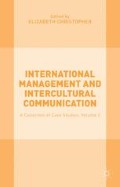Abstract
The following case study is of the concept of “distributed space” — not as a technical term as in time block coding in wireless communication, for example,1 but as a form of international and intercultural communication, specifically in academic environments. Growing evidence of the importance of this topic is provided, for example, by the March 2015 conference in Sydney, Australia: New Generation Learning Space Design 2015,2 to explore how massive adoption of new technologies, changing curricula and transformation of student study habits have resulted in education institutions needing to rethink teaching and learning environments.
Access this chapter
Tax calculation will be finalised at checkout
Purchases are for personal use only
Preview
Unable to display preview. Download preview PDF.
Notes
S. Ejaz, 15 December 2013, “A brief introduction to distributed space time block coding in wireless communication,” http://www.slideshare.net/SikanderEjaz/distributed-space-time-block-coding, 15 February 2015.
S. Heath, 1976, “Narrative space,” Screen, 17(3), 68–112.
A. Harrison and L. Hutton, 2014, Design for the changing educational landscape: space, place and the future of learning (Routledge).
CABE, 2005, “The impact of office design on business performance,” Commission for Architecture & the Built Environment and the British Council for Offices, 11, http://webarchive.nationalarchives.gov.uk/20110118095356/ http://www.cabe.org.uk/files/impact-office-design-full-research.pdf.
P. Gaston, 2010, The challenge of Bologna: What United States education has to learn from Europe, and why it matters that we learn it (Virginia: Stylus Publishing)
AMA Alexi Marmot Associates, 2006 report for the Scottish Funding Council, “Spaces for learning; A review of learning spaces in further and higher educa-tion”. SFC 2006: 4.
N. Salingaros, 2007, Anti-architecture and deconstruction (Umbau-Verlag), 120.
R. Barr and J. Tagg, November/December 1995, “From teaching to learning — a new paradigm for undergraduate education” in Change, 13–25, retrieved from http://ilte.ius.edu/pdf/barrtagg.pdf.
M. Knowles, E.F. Holton and R.A. Swanson, 2011, The adult learner: the definitive classic in adult education and human resource development (Elsevier, Oxford: Butterworth-Heinemann).
M. Neary, A. Harrison, G. Crellin, N. Parekh, G. Saunders, F. Duggan, S. Williams and S. Austin, 2010, “Learning landscapes in higher education,” Centre for Educational Research and Development, University of Lincoln, retrieved from: http://learninglandscapes.blogs.lincoln.ac.uk/files/2010/04/FinalReport.pdf.
G. Graham, 2002, Universities: the recovery of an idea (Thorverton, UK: Imprint Academic), 199.
Editor information
Editors and Affiliations
Copyright information
© 2015 Andrew Harrison
About this chapter
Cite this chapter
Harrison, A. (2015). Space to Learn: A Case of Distributed Space. In: Christopher, E. (eds) International Management and Intercultural Communication. Palgrave Macmillan, London. https://doi.org/10.1007/978-1-137-55325-6_11
Download citation
DOI: https://doi.org/10.1007/978-1-137-55325-6_11
Publisher Name: Palgrave Macmillan, London
Print ISBN: 978-1-349-56379-1
Online ISBN: 978-1-137-55325-6
eBook Packages: Palgrave Business & Management CollectionBusiness and Management (R0)

